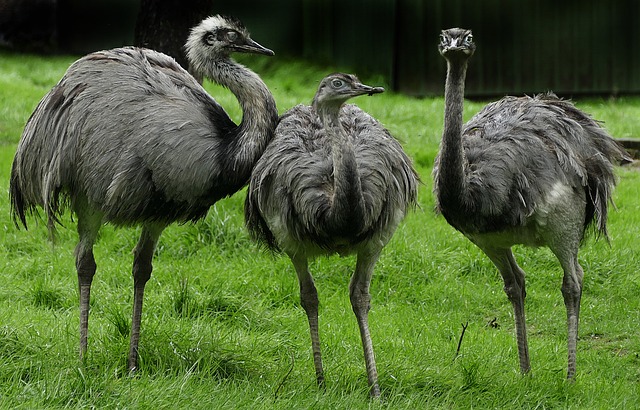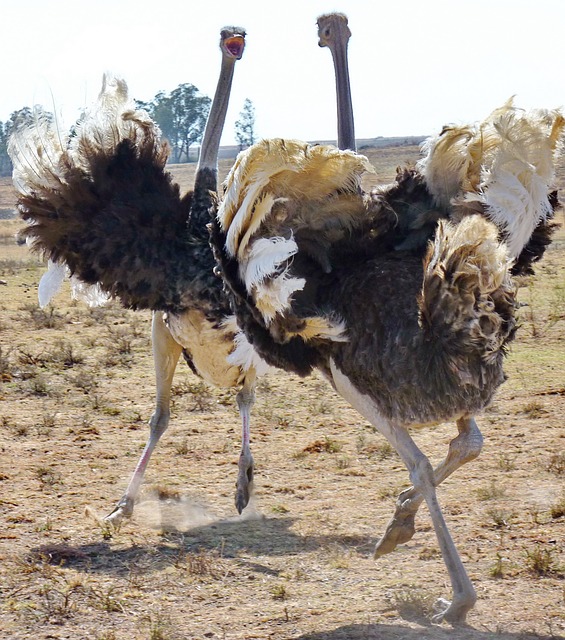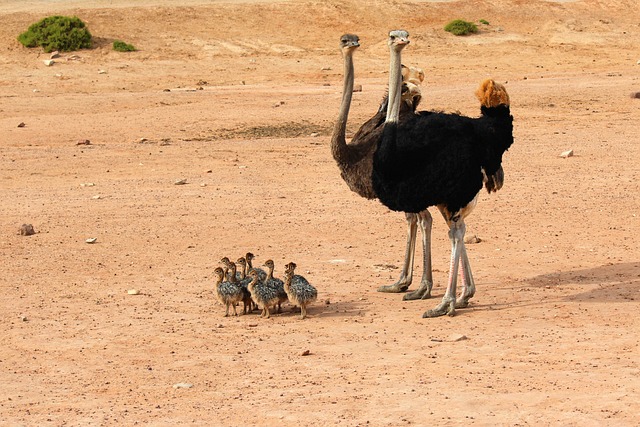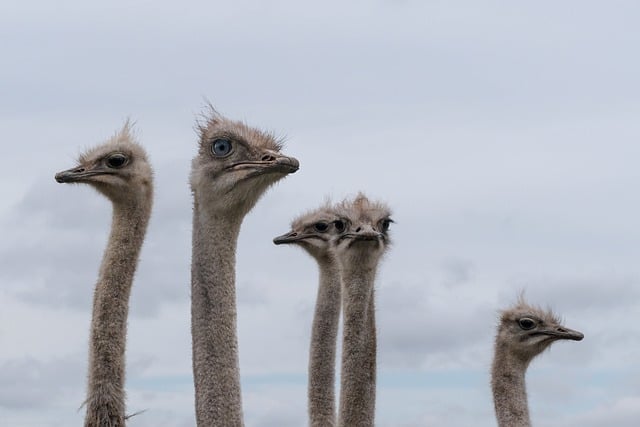Welcome to the world of the Rhea, the giant South American bird that roams the vast grasslands and forests of this diverse continent.
This impressive bird, also known as the American ostrich, has captured the attention of researchers and nature lovers alike with its unique characteristics and behaviors. In this article, we will take an in-depth look at the Rhea, exploring its physical features, habitat, diet, and adaptations for survival.
Our aim is to shed light on the significance of this magnificent bird in the ecosystem and its relationship with humans. So, let's dive into the fascinating world of the Rhea and discover all there is to know about this remarkable species.

Physical Characteristics of the Rhea
The Rhea, also known as the South American ostrich, is a fascinating and unique bird that can be found in the grasslands and shrublands of South America. This giant bird stands at an impressive height of up to 5 feet and can weigh up to 80 pounds, making it the largest bird in South America and one of the largest birds in the world. Its unique physical characteristics make it stand out in the animal kingdom, and it plays a crucial role in its ecosystem.
The Rhea has a distinct appearance with its long, slender legs and a large body covered in soft, fluffy feathers. Its feathers come in a variety of colors, ranging from gray, brown, and white, providing excellent camouflage for the bird in its natural habitat. These feathers also serve as insulation against the harsh elements, keeping the Rhea warm during the colder months.
One of the most remarkable features of the Rhea is its wings. Unlike most flightless birds, the Rhea has small wings that are not strong enough for flight. However, these wings are not entirely useless as they help the Rhea balance while running and can also be used for display during courtship rituals. The Rhea also has a powerful kick, which it uses to defend itself against predators.
The Rhea is well adapted to the grasslands and shrublands of South America, and its physical characteristics play a vital role in its survival. Its long legs make it an excellent runner, reaching speeds of up to 40 miles per hour, making it one of the fastest birds on land. This is a useful adaptation for escaping predators such as foxes, pumas, and small carnivorous birds.
The Rhea's feathers also serve as a defense mechanism, as they can puff up and make the bird look larger when threatened. This is known as piloerection and is a common behavior among birds to intimidate predators. Additionally, the Rhea's feathers also help it blend into its surroundings, making it more challenging to spot by potential predators.
In terms of its physical capabilities, the Rhea also has excellent eyesight and hearing. This enables it to detect predators from a distance and take necessary action to protect itself. The Rhea also has a keen sense of smell, allowing it to find food and water sources in the vast grasslands.
Habitat and Distribution
The Rhea, also known as the Greater Rhea, is a flightless bird native to South America. This large and majestic bird can be found in a variety of habitats throughout the continent, from grasslands to scrublands and even wetlands. Its distribution spans from the southern tip of Argentina all the way up to the central regions of Brazil.
The Rhea's natural habitat is primarily the open grasslands of South America, which provide an ideal environment for their large size and grazing habits. They are also known to inhabit areas with shrubs and low-lying vegetation, as well as floodplains and savannas. These habitats provide the Rhea with ample space to roam and forage for food.
The distribution of the Rhea is largely influenced by the availability of food and water sources. In the northern regions of its range, where food is more abundant, the Rhea is more widely distributed. However, in southern regions where resources are scarce, their distribution is more limited. The Rhea is also found in different altitudes, ranging from sea level up to 3,000 meters in the Andes mountain range.
Unfortunately, the Rhea's habitat and distribution are facing threats due to human activities. The conversion of grasslands for agriculture and urbanization has led to the fragmentation of their habitat. This has forced the Rhea to compete for resources and navigate through man-made barriers. In addition, the introduction of non-native species, such as feral dogs, has also posed a threat to the Rhea's population.
Conservation efforts have been put in place to protect the Rhea's habitat and distribution. In Argentina, the Rhea National Reserve was established to safeguard their natural habitat and promote conservation efforts. This reserve also serves as a research center to study and monitor the Rhea's population and behavior. In Brazil, the Rhea is listed as a vulnerable species and is protected by law. This has helped to regulate hunting and ensure their survival.
The Rhea's distribution also plays a significant role in the ecosystem. Their grazing activities help to maintain the health of grasslands and prevent the overgrowth of vegetation. This, in turn, benefits other species that share their habitat. The Rhea's feathers and manure also contribute to the nutrient cycling process, making them an important part of the ecosystem.

Diet and Feeding Habits
The Rhea is a large, flightless bird native to South America. As herbivores, they have a varied diet consisting of plants, fruits, and seeds. Their feeding habits play a crucial role in maintaining the balance of their ecosystem.
The Rhea's diet mainly consists of grasses, leaves, and herbs found in their natural habitat. They are opportunistic feeders and will also consume fruits and seeds when available. This varied diet provides them with essential nutrients and energy to survive and thrive in their environment. The Rhea's long, slender beak is well-adapted for foraging and allows them to reach deep into the ground for roots and tubers.
Their feeding habits are also influenced by their natural surroundings. During the rainy season, when food is abundant, the Rhea will graze in large groups. However, during the dry season, when resources are scarce, they will forage alone or in smaller groups, making it easier to find food. This behavior also helps to reduce competition for resources within the group.
One interesting fact about the Rhea's feeding habits is their ability to swallow rocks, known as gastroliths. These rocks help to grind up tough plant material in their stomachs, aiding in digestion. This behavior is essential for their survival as they do not have teeth to break down their food.
As important members of the food chain, the Rhea's diet and feeding habits also play a significant role in the ecosystem. The seeds and fruits they consume are later dispersed through their feces, helping to spread plant life and promote biodiversity in their habitat. They also help control the growth of vegetation by grazing on grasses, which prevents them from overgrowing and competing with other plants.
In addition to their diet, the Rhea's feeding habits also include unique behaviors. They are known to dust bathe, a process where they roll in the dust to remove parasites and keep their feathers clean. This behavior is crucial for their overall health and well-being.
Despite being herbivores, the Rhea may occasionally consume insects or small vertebrates like lizards or mice. This behavior is more common during the breeding season when they need extra protein and nutrients.
Life Cycle and Reproduction
The life cycle and reproduction of the Rhea is a fascinating and unique process that sets it apart from other birds. Like most birds, the Rhea's life cycle begins with the mating season, which typically occurs between August and January. During this time, the male Rheas compete for the attention of the females by displaying their elaborate courtship dances and vocalizations.
Once a male and female pair up, they will build a nest together on the ground using grasses, leaves, and twigs. The female will lay an average of 10-12 eggs, which will be incubated for 35-40 days. What sets the Rhea apart from other birds is that the male is the primary caretaker of the eggs and young. He will take on the role of incubating the eggs and caring for the newborn chicks, while the female may mate with other males.
The male Rhea has a unique adaptation that allows him to incubate the eggs in a way that is different from other birds. He has a brood patch on his chest, which is a bare area of skin with an abundant supply of blood vessels. This patch of skin helps him regulate the temperature of the eggs by sitting on them and keeping them warm. The male Rhea is also responsible for protecting the nest and chicks from predators, using his strong and powerful legs to kick and defend them.
Once the chicks hatch, they are able to walk and forage for food within a few hours. They will stay with their father for the first 6-10 months of their lives, learning important survival skills and behaviors. The young Rheas will reach sexual maturity at around 2 years old, and the whole process begins again.
It is worth noting that the Rhea's reproductive cycle is very dependent on environmental factors. When resources are scarce, such as during times of drought, the female Rhea may delay or even skip breeding altogether. This is an important adaptation that ensures the survival of the species during times of hardship.
The Rhea's unique reproduction process has played a significant role in its survival and success. By having the male take on the responsibility of incubating the eggs and caring for the young, the female is able to mate with multiple males, increasing genetic diversity within the population. It also allows the female to conserve energy and resources, ensuring her own survival and the survival of future offspring.
Adaptations for Survival
The Rhea is a remarkable bird that has evolved to survive in the harsh and diverse environments of South America. From its physical characteristics to its behavioral patterns, the Rhea has developed various adaptations that have helped it thrive in its habitat. In this section, we will delve deeper into the Rhea's adaptations for survival and how they play a crucial role in its existence.
Physical Adaptations:
The Rhea's physical appearance is a direct reflection of its environment and lifestyle. On average, a Rhea stands at 4.9 feet tall and weighs around 66 pounds, making it the largest bird in South America. Its massive size serves as a defense mechanism against predators, making it less vulnerable to attacks.
Additionally, its long, powerful legs and strong claws enable it to run at high speeds, reaching up to 60 kilometers per hour. This allows the Rhea to escape from potential threats and cover long distances in search of food and water.
Feathers and Wings:
The Rhea's feathers also play a crucial role in its survival. Not only do they provide insulation to withstand extreme temperatures and protect the bird from the sun's rays, but they also come in handy during the mating season. The male Rhea's feathers are used to attract females during courtship, while the female's feathers are used as camouflage to hide from predators while nesting. Moreover, the Rhea's wings, although small, allow it to balance and maneuver while running, providing stability and agility.
Behavioral Adaptations:
The Rhea's behavior has also adapted to ensure its survival in its natural habitat. One of the most notable adaptations is its communal living. Rheas live in groups of 6-10 individuals, allowing them to protect each other and share resources. This behavior also helps in the rearing of young, as females lay their eggs in communal nests, and all members of the group take turns incubating them. This ensures the survival of the eggs and increases the chances of the chicks' survival.
Adaptations for Food:
The Rhea's diet consists mainly of plants, seeds, fruits, and insects. To access these food sources, the Rhea has evolved a unique digestive system. Unlike other birds, the Rhea has multiple stomachs, including a gizzard that helps grind tough plant materials. This adaptation allows the Rhea to digest a wide variety of foods and ensures its survival in times of food scarcity.
Conservation Efforts:
Despite its remarkable adaptations, the Rhea's population is facing threats from human activities, such as habitat destruction and hunting. To protect this magnificent bird, several conservation efforts have been put in place. These include the creation of protected areas and implementing sustainable farming practices that minimize the impact on the Rhea's habitat. Additionally, education and awareness programs have been established to promote coexistence between humans and the Rhea.
Relationship with Humans
The Rhea has long been a part of South American cultures and has played a significant role in their history. These giant birds have been revered and even worshiped by some indigenous communities, while also facing challenges and conflicts with humans in modern times.
Historical and Cultural Significance:
The Rhea has a rich history and cultural significance in South America. Its feathers were used for decoration and ceremonial purposes by indigenous peoples, and even today, its image can be seen in traditional artwork and textiles. In some cultures, the Rhea is seen as a symbol of fertility and abundance, and its eggs were sometimes used in religious rituals.
Challenges and Conflicts:
As human populations continue to expand and encroach upon the Rhea's natural habitat, there have been some challenges and conflicts between the birds and humans. One of the main issues is the destruction of their habitats due to agriculture and urbanization. This has resulted in a decline in their population and forced them to adapt to different environments.
Another challenge for the Rhea is hunting and poaching. Their large size and flightless nature make them easy targets for hunters, and their feathers and eggs also hold value in the black market. In some areas, the Rhea is hunted for its meat, which is considered a delicacy by some.
Conservation Efforts:
To protect the Rhea's population and their habitats, conservation efforts have been put in place. In countries like Brazil, Argentina, and Uruguay, the Rhea is a protected species, and hunting is strictly regulated. Additionally, there are initiatives to educate local communities about the importance of preserving the Rhea and its habitat.
In some areas, ecotourism has also become a way to generate income while promoting the conservation of the Rhea. Tourists can observe these birds in their natural habitats, and this provides an economic incentive for local communities to protect the birds and their environment.
Tourists can also contribute to conservation efforts by being responsible and respectful when visiting Rhea habitats. This includes not disturbing their nesting sites and following designated paths to minimize any potential impact on their habitats.



